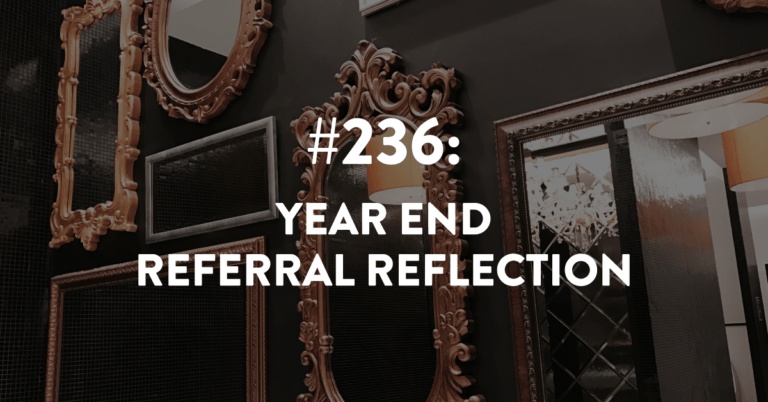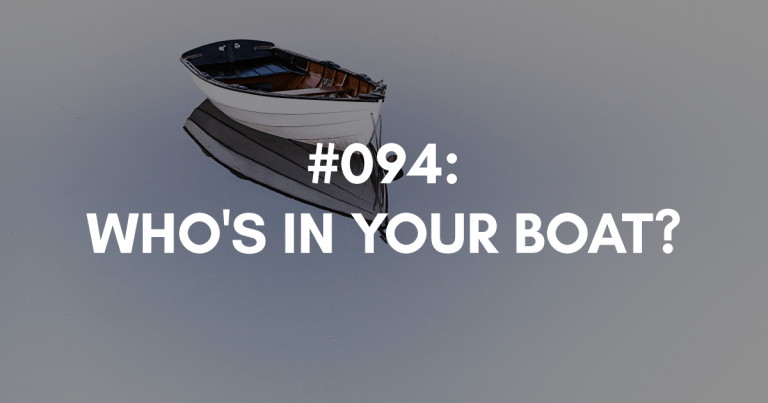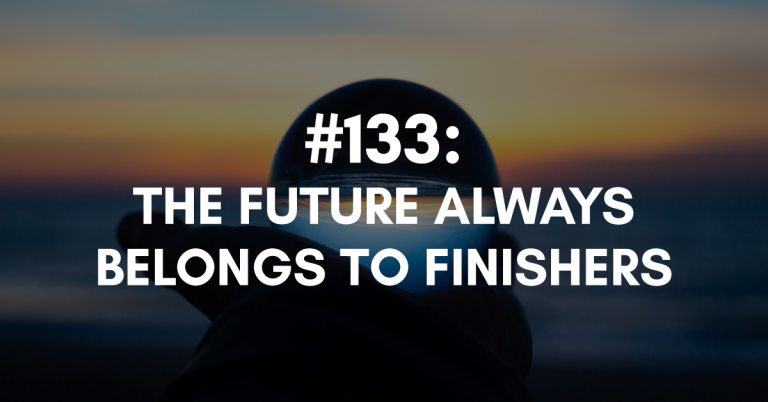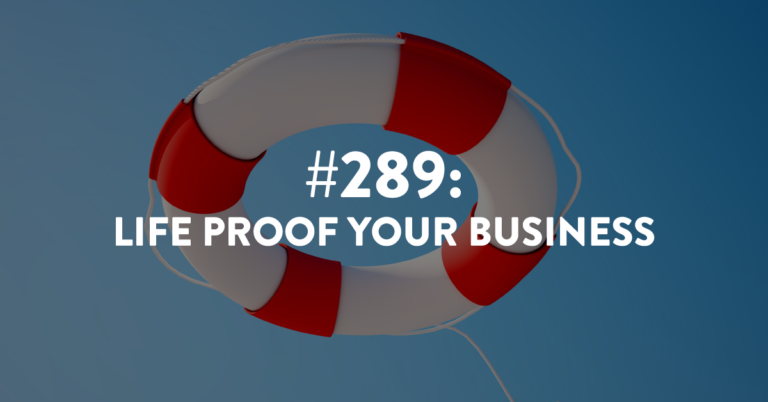Ep #332: Upstream vs Downstream Referrals
When it comes to referrals, it’s important to know the difference between upstream and downstream referrals. This helps you find the right people or businesses to connect you with your ideal clients.
Upstream Referrals are those who talk to your potential clients before you do. They help identify problems that you can solve. Think of them as ones who swim upstream, uncovering needs before you even get there!
Downstream Referrals are those who find it challenging to refer clients to you. They often don’t have the conversations that reveal the problems you solve. It’s like trying to swim against the current!
Understanding who swims upstream from you is key! These are the people you want to cultivate relationships with. They can help you connect with your ideal clients by identifying their needs first, leading to more effective referrals for your business.
Take a moment to reflect on who your ideal clients are and who might be swimming upstream or downstream from you. Who do you think fits into these categories?
Feel free to send me an email, and I would be happy to provide my feedback.
Links Mentioned During the Episode:
Want to dip your toe in with our Starter Course? It’ll be the best $500 you spend to get Your Next 5 Referrals.
Want to work with me so I can help you 2x, 3x, 4x your referrals over last year? Then apply to work with me inside my coaching program, Building a Referable Business. Please submit your application now.
Want me to build your Referral Strategy for you? Then check out my VIP Referrals In A Day service where I handle the heavy lifting for you. First step is to apply to see if you’re a fit and then we’ll schedule a call. (*A minimum of a 2-person team is required for this Done-For-You service.)
Next Episode:
Next episode is #333, which is another episode created with you and your needs in mind.
Download The Full Episode Transcript
Read the Transcript Below:
Stacey Brown Randall: Upstream referrals? Downstream referrals? Whatever am I talking about?
Hey there, and welcome to episode 332 of the Roadmap to Referrals podcast, a show that proves you can generate referrals without asking or manipulation.
I’m your host, Stacey Brown Randall. My journey from a business failure to a successful business now 11 years in, I know generating referrals naturally and consistently has made all the difference. Working with clients around the world, we leverage the science of referrals. protect relationships above all else, and help you build a referable business.
So throughout a few episodes, I have mentioned this idea of upstream versus downstream referrals. We talk about it a good amount inside my coaching programs and when I’m working with my VIP clients, helping them understand this concept and really understanding the difference between upstream and downstream referrals.
And so I wanted to make sure you guys had the same clarity when it comes to upstream versus downstream referrals, because it really gets to the heart of who you want to generate referrals from, and I want you to be as crystal clear with it as my clients. So let’s get you the same clarity.
First, think of a stream. How does the water flow? Only one direction. That is the visual I need you to keep in mind as I am describing to you upstream and downstream referrals.
So let’s start. What are upstream referrals?
Upstream referrals, the way that I define it, is those are the people who swim upstream from you, which means they are going to be talking to your clients or your potential clients before you do. They help your clients understand that they have a problem that maybe then you will be able to solve.
Now, this is not like the intentionality behind people who swim upstream for you. They’re not necessarily looking for the problems you solve. It just means that they are working with their clients, and it will naturally become something that is up for discussion or is uncovered in conversation with their clients that they have something else they need to deal with, but that person doesn’t do it.
So by definition, this person swims upstream from you, right? It is typically another company, another business owner, who swims upstream from you, is having conversations with your ideal clients before you do. They know about the problems those clients need to fix before you do.
Now, it doesn’t always have to be a business owner having a conversation with their clients, and then they discover that there’s other problems they need to solve, meaning you would be the perfect fit for them.
Sometimes it’s just people who have conversations with other folks and because of the level of trust or relationship that they have or maybe they’re in the same networking groups or whatever it is, they are having conversations with other people and the topic of conversation will come around a problem they need to solve and then of course there you are as someone who can solve it.
But these people swim upstream from you, meaning they are hearing about the problems that you can solve. They are hearing about those problems from people that have the problems before you do. They swim upstream from you.
What we want is for those people to uncover said problem from that person and say, Hey, wait, I need to send you down the river and you need to stop and talk to Sam. You need to stop and talk to Jennifer. You need to stop and talk to Jonathan, right? That’s what we want.
We want the people who swim upstream from you who were there when problems are identified that you can solve, and then that person floats them on down the river to you. Effectively sends them to you.
I know I’m going to probably take this river analogy like way too far. Or am I supposed to say river metaphor? Whatever, I’m gonna take it way too far with what I say, but it’ll be fun for both of us. So here we go.
Okay, so that’s what an upstream referral is, right? Referrals that swim upstream from you are where the people hear about the problem you can solve first, and then the goal is for them to give those to you. To pass those potential clients on to you. They get there first, they swim upstream.
Now, of course, a downstream referral for you is the opposite of an upstream. A downstream referral is someone who actually, they can’t, they don’t hear about the problems, so it’s really hard for them to refer to you. That doesn’t mean they can’t.
I do want to say this. That doesn’t mean people who don’t swim downstream from you can’t refer to you. It just is really hard to refer upstream. It’s really hard to move upstream against the current.
So when you have downstream referrals, for what I try to have people understand with this is that there are just some people who swim upstream from you and they come across problems before you would. They’re talking to your clients and identifying things before you would. And that’s why they can come down to you, downstream to you.
But people who are downstream from you, they rarely can actually send referrals back to you. What they’re hoping is that you can send referrals to them. See how that works?
So when people are defining and they’re trying to build out, okay, who is my ideal referral source? Like if I’m looking at people to refer me that are not my clients.
So of course, clients is one bucket of group of folks who can refer to you. But if you’re looking for another group, another bucket of folks to refer you, and we’re not talking about clients, we’re typically talking about contacts and specifically centers of influence, right?
The people who know what you do, don’t do what you do, so there’s no competitive overlap and come across your ideal client with some level of regularity.
But when you’re talking to people who swim downstream from you, I see a lot of people try to cultivate relationships. And what they realize is, is that the people who swim downstream from them, they never have the type of conversations with other people and or their clients that would reveal a problem that we can solve.
So when we’re having people, when we’re trying to cultivate relationships with people who are downstream, if they’re never going to be able to identify a problem and somebody to be able to refer that person to you, they won’t refer to you.
So it’s just harder for people who are downstream from you to refer upstream to you, just like it’s sometimes hard for you to refer to the people who are upstream from you. But everybody always has somebody upstream from them. And we all have somebody who swims downstream from us as well.
And if we’re really good at giving referrals, then we should also be really good at receiving referrals and understanding kind of how the flow of that river, of that stream, or the flow of the current ultimately works.
So I use this analogy, though, when I’m trying to have people understand who you should be focused on generating referrals from.
So a great example I’ve always used is that when I was a business coach, I would always be having conversations. So I was a business coach and I was specializing in productivity. I was always having conversations with my small business clients that you need to be outsourcing more. And one of the things I thought everybody should outsource is bookkeeping.
So of course, naturally, I swam upstream from the bookkeeper that I referred to. I was identifying those problems in my clients, and she just had to wait for the referral.
I’m having the conversations. That’s a trusted conversation with someone saying, hey, you need to outsource more. Something you could outsource is your bookkeeping. Bookkeeping, it doesn’t cost a fortune every month, depending, I mean, that has a lot to do with how complicated your business is. I’m like, this is one of the easiest things to outsource.
So when I would have conversations with business owners and I’d be like, you need to outsource, I was a trusted resource telling them, right? I was a trusted partner. I was a trusted advisor telling them, we need you to outsource this. And here’s someone I recommend. Here’s someone that I would refer you to.
So I was upstream from my bookkeeper, but it didn’t always work the other way around. right? It didn’t always work that way. It can, right? And it has, right?
So when I have somebody who is having conversations with clients, and they are maybe a business coach themselves, or maybe they are a bookkeeper, and they’re having conversations about you need to grow more, we need to get you like more business. And then they have a conversation about referrals, right?
In that case, they’re identifying a problem in a client. And then they can hand that person to me, just because based on what I do, So it’s just, it’s really important that you’re paying attention to use this to determine who should be referring to you, right? Who you should be identifying and cultivating as potential referral sources.
So when you make that ideal center of influence list, think about people who are swimming upstream from you, and not the ones who are swimming downstream. That doesn’t mean you’re gonna get this perfectly like the very first time you do it, but that is ultimately what I want you thinking about, okay?
So I wanna take a minute and I want you to spend some time thinking about who swims upstream versus who swims downstream. So let me give you a few more examples as well.
Stacey Brown Randall: Hey there, pardon the interruption. do you wanna know how to work with me? You can get started with the basics of referrals and getting them in place with my online starter course, Your Next Five Referrals.
If you’re ready to learn all of my referral strategies and you want access to me as you build and implement them, then you should apply to join my Building a Referable Business coaching program.
But if you have a small team and you want me to build your referral strategy for you and then spend time on the ground with you for two days and then be on call as you’re implementing, then you need to apply for my VIP referrals in a day experience.
Links to all three ways to work with me can be found on the show notes page for this episode. Okay, let’s get back to the episode now.
Stacey Brown Randall: Again, it’s important that you’re thinking about this from the perspective of who should be referring to you, right? Who should you be able to identify and cultivate because they have potential to refer to you? Who swims upstream from you?
And then paying attention to when you have people on your list that you want referring to you, well, actually, are they not doing it because they swim downstream? So just take a minute and think about who this is for yourself.
And actually, I would love it if you want to shoot me an email, if you’re on my email list and you get my emails, shoot me an email and tell me who you think swims upstream from you versus downstream.
I don’t need like a list of 10 people, but just give me a couple of ideas of who swims upstream and who swims downstream. Now put this in context for me, right? I kind of need to know like what you do, and like who your idle client is so that I can understand and have context around who you believe swims upstream versus downstream.
And I would be happy to review that list and come back with any questions that I have for you or things maybe you haven’t thought about. So if you’re willing, you can shoot me an email and I can help you figure out who is downstream versus upstream. from you.
But for those of you who are not going to do that, because you’re listening to me while you’re working out or, you know, it’s October now, we’re not really cutting the grass anymore as much as we are blowing leaves.
So if you’re listening to me while you’re doing something else, maybe you’re even commuting, then just take a minute and think about it. Think about who your ideal client is, right? So this is the process of how I want you to think about it.
Think about who is your ideal client? Who else are they hiring? Or are they working with, where conversations could be uncovered or could bubble up, where the problem that you solve would be identified.
Now, I used the business coach to bookkeeper analogy, right? So that’s one, right? Now here’s the thing. Sometimes you can make the argument that people that you need to refer to also need to refer to you. That’s great, right?
Sometimes you can have a few types that are gonna be, hey, they swim upstream and downstream for me, and that’s totally fine. It’s just not, it’s a little bit more rare than you kind of actually understand, right? Just a little bit more rare.
So an example I used when I was a productivity coach telling my clients to outsource some things, bookkeeping being the one of the things I would tell them to outsource ASAP, that’s because I was being hired as a productivity business coach.
I don’t have those conversations with my clients anymore, right? The conversations I have with my clients now, teaching them, being on the sales side or the business development side and helping them generate referrals without asking for them, I don’t have outsourcing conversations, productivity type conversations with them all that much.
That doesn’t mean they don’t happen. Absolutely. But they just don’t happen the same way they used to. So it is something for you to keep in mind as you’re thinking through who you swim upstream from and who swims downstream from you as well. But just take a minute and think about it.
Now we’re thinking about this outside of the clients. We understand that clients, and they could come from a variety of industries and backgrounds, and that’s great, depending on who you serve.
We’re not talking about clients here. We’re talking really about those centers of influence, right? Those other people, other business professionals that do come across your ideal client and could refer them to you because of how they swim. Upstream or downstream from you.
So let’s talk about this from an interior designer perspective. So quite possibly, if you bring somebody in to do window treatments or wallpaper or painting, they swim downstream from you.
So if you’re the interior designer who is managing a renovation, and you were hiring a bunch of vendors, or what’s referred to as trades, in the interior design business, if you’re hiring a bunch of people who are in the trades, you’re hiring your wallpaper person that’s gonna hang the wallpaper, you’re hiring your painter.
You’re hiring the person who’s gonna do the woodworking to build that new cabinet you need for that bar unit you’re putting into in the dining room, whatever it is, those trades people usually, not always, but usually swim downstream from you.
They are looking to get referrals from you when you have those jobs where you need wallpaper and painting and trim work, right?
On the flip side of that though, swimming upstream from you are probably the builders, the architects, the contractors that are needing a designer to pull everything together, and quite frankly, probably make sure everything looks good when it’s all said and done, right?
So they’re looking to work with an interior designer. So that’s just another example of upstream versus downstream.
Let’s say you’re a marketing agency. Actually, you know what? I want to do a different one. I want to use a different example.
I want to use an example of, let’s say you’re an HR consultant. And so who has conversations with your clients, which are probably business owners or heads of HR departments? Who has conversations with them and helps them realize you have a problem that we cannot solve internally, and we need to bring in outside help to do that? Who’s having that conversation with them?
Is it other consultants that may be working in the business? Hey, I’m in there as a fractional CFO, and they have some serious culture issues. I’m going to make a recommendation and referral to the HR department to probably bring in an HR consultant.
So who are the people who are having those conversations and having those dialogues and help people identify their problems, sometimes before the person knows that they have a problem, but then when they’re aware, they get to make the decision, do I want to work on this? Is this a problem I want to solve?
Okay, so that’s just a couple of examples, but I want you to think through what this looks like for you. And again, my offer for you to share what you do, so I have some context, who your ideal client is, and who you believe swims upstream and downstream for you.
I would love it to be able to get an email from you and respond back. I may not respond back the same day, so let’s recognize I may need a little bit of time to get back to you, but if you are willing to email me that information, I am willing to look through it and give you any thoughts that I have as well.
I think that would be, well, super valuable for you and I think fun for me, so email me and let me know what you think.
Alright, the show notes page for this episode can be found at StaceyBrownRandall.com/332, which is of course also where you always will find the links to the resources mentioned in any episode.
We’re back with another great episode next week created with you and your needs in mind. Until then, you know what to do, my friend. Take control of your referrals and build a referable business. Bye for now.







